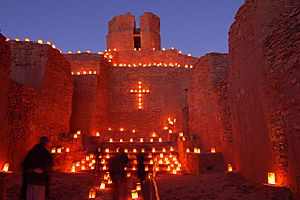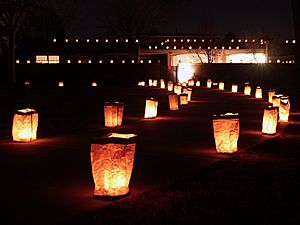Luminaria facts for kids
A luminaria or farolito is a small paper lantern. It's usually a candle placed in some sand inside a paper bag. These lanterns are very popular in the Southwestern United States, especially around Christmas time on Christmas Eve.
They are very important in New Mexico. They are a special part of the culture for the Pueblo people and Hispanos of New Mexico. These paper lanterns have mostly taken the place of an older tradition, which used larger fires called "vigil fire luminarias."
Another type of luminaria is a small torch or large candle. This is carried by the leader during the Las Posadas procession. This holiday lasts for nine days, from December 16 to 24.
You can also find electric luminarias. These are strings of regular Christmas lights. The bulbs are covered with a tan plastic sleeve, which looks like a small paper bag.
Contents
Where Did Luminarias Come From?
The idea of using paper lanterns during Christmas processions comes from the Philippines. There, people use similar lanterns called parol (which means farol in Spanish). These lanterns are made from bamboo and Japanese paper. They were brought to New Spain (which included parts of North America) by ships called Manila galleons.
Christmas Traditions with Luminarias
The first luminarias were actually small bonfires. They were made from crisscrossed piñon branches, stacked about three feet high in squares. Today, most luminarias are made from brown paper bags. They are weighted down with sand and lit from inside by a candle. People usually arrange them in rows to create big, beautiful displays. Many Roman Catholics believe these lights help guide the spirit of the Christ Child to their homes.
You can also buy artificial luminarias. These have plastic bags lit by small light bulbs and are connected by an electrical cord. They are very common in the American Southwest. People often display them throughout the whole holiday season. They have also become popular in other parts of the United States.
Luminarias in New Mexico
Santa Fe and Old Town Albuquerque in New Mexico are famous for their amazing Christmas Eve farolito displays. Farolito displays are common all over New Mexico. Most towns have farolitos in important areas like main streets or parks. People often line their yards, fences, sidewalks, and roofs with farolitos. Similar traditions are now found in many other parts of the country.
The University of New Mexico in Albuquerque, New Mexico has an event called the "Hanging of the Greens." It features over 14,000 luminarias, hot posole (a traditional stew), and Christmas carols.
New Mexico State University in Las Cruces, New Mexico holds an event called "Noche de Luminarias" in early December. It features over 10,000 luminarias all around the campus.
San Juan College in Farmington, New Mexico, organizes a huge yearly farolito display. Recently, they had about 30,000 farolitos on campus.
Luminarias in Other Places
At historic Temple Square in Salt Lake City, Utah, metal luminarias decorate the grounds. These are near the Church Office Building of the Church of Jesus Christ of Latter-day Saints. Tiny holes are punched in the metal to create designs. These designs show scenes from the life of Jesus Christ and Christmas messages in different languages. Some are shaped like traditional bags, while others are large cans.
In West Valley City, Utah, luminarias light the path during the "Walk with Santa." This event happens on the first Monday of December each year. The display includes over 300 luminarias.
The American Cancer Society holds "Relay For Life" fundraising events across the U.S. These events often have luminaria ceremonies. Luminarias are placed around the track. Some events even spell out "HOPE" in stadium stands using luminarias.
Luminarias have also become popular in some cities in California. Boy Scout Troops and the Albuquerque Youth Symphony sell them around Christmas. This helps them raise money for their groups.
On Evensham Street in Truckee, California, local residents line the streets with luminarias.
The Mantey Heights neighborhood of Grand Junction, Colorado has celebrated the luminaria tradition for many years. Over 3,500 luminarias are placed along the roads and walkways every Christmas Eve. Many are placed on top of the walls of old adobe homes.
In Champaign, Illinois, luminarias line South Willis Ave. for one night each holiday season.
In Galena, Illinois, luminarias line the streets of the town one night in December for their "Night of Luminaria."
In the Village of Glen Ellyn, Illinois, luminarias line a block of Taylor Avenue on Christmas Eve.
In Midlothian, Illinois, luminaria sets are sold to raise money for local food pantries. About 75% of the food pantries' yearly budget comes from these sales and donations.
For the past 22 years in Seattle, people have placed luminarias along the path next to Lake Washington. They place as many as 1,800 along a three-mile stretch of the path. This is timed to happen with the annual Christmas Ships festival.
In Southern Arizona, at the Tumacacori Mission, 2,500 luminarias are placed around the mission and lit on Christmas Eve. People from the community visit the mission and walk through the church and grounds. It's a very special tradition for the community.
Luminarias for Other Holidays
In some Southwestern states, like Arizona, Texas, and New Mexico, luminarias are sometimes used as Halloween decorations. They might even have jack-o'-lantern faces drawn on the paper bags. You can find artificial luminarias with different holiday patterns and colors now, not just brown.
What's in a Name? Farolito or Luminaria?
The name of this decoration causes a bit of a friendly debate among some people in New Mexico. Generally, farolito is the preferred name in northern New Mexico. In the southern part of the state, they are often called luminarias. The central area around Albuquerque uses both names.
In Spanish, farolito means "little lantern." The word luminaria means "festival light." Historically, luminaria actually referred to a small festival or vigil bonfire, not a paper lantern. However, most people outside of northern New Mexico don't make this difference.
Some New Mexico traditionalists believe that calling a paper lantern a luminaria isn't quite right. While some might call farolitos "luminarias," on Christmas Eve in Santa Fe, farolitos are lit. At the same time, in the small mountain villages of Northern New Mexico, larger luminaria bonfires are burning. These bonfires are made of stacked piñon and juniper wood. They are built by local residents to welcome visitors and celebrate the holidays.
See also
- Festival of Lights
- Kobe Luminarie, a December electric-light festival in Japan
- Christmas lights
- Luminarias festival observed annually in San Bartolomé de Pinares





